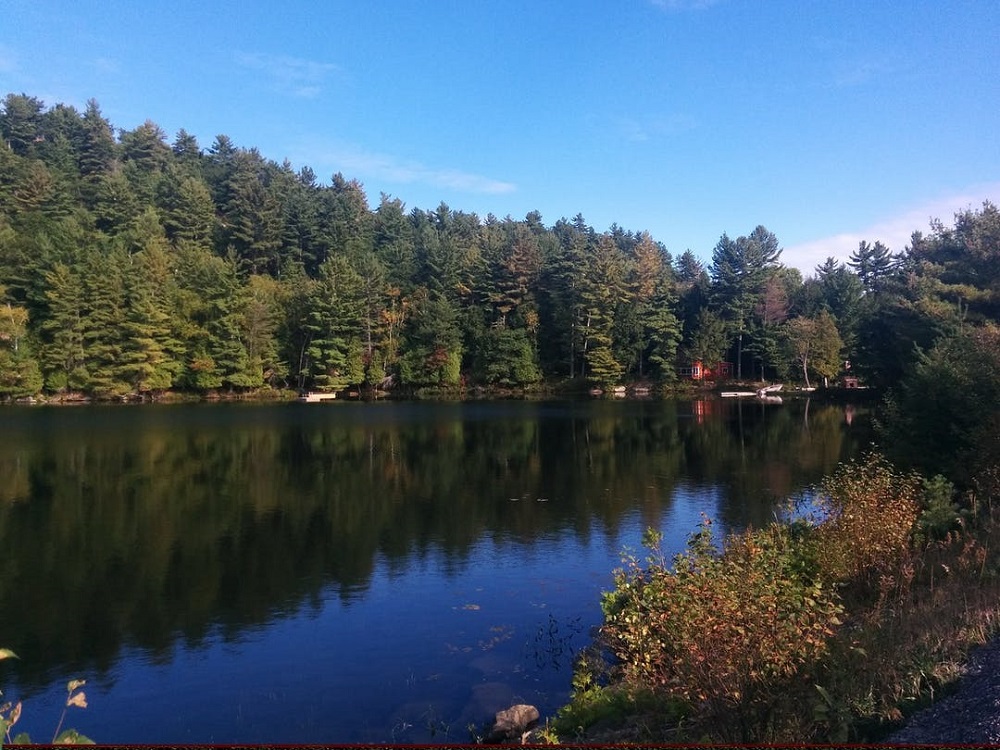The County’s draft shoreline bylaw has generated concern and confusion within the community.
The bylaw was tabled by council Jan. 27, with the municipality planning to have an outside consulting firm take on the process.
The move came after public outcry against the bylaw – from builders, landscapers and property owners concerned about its scope and the impact it could have on business.
“Haliburton County needs a workable bylaw that will serve to protect water quality but at the same time does not diminish individual property rights,” Brightwood Landscaping said in a Facebook post. “If the bylaw is adopted as currently written, most projects will never occur.”
On the other side of the debate are groups such as the Coalition of Haliburton Property Owners Associations (CHA), concerned about lake health and property values, who note natural shorelines are important to protect water quality and prevent algae-blooms.
Why a 30-metre setback?
One point of pushback has come against the proposed 30-metre setback from shorelines – already present in the existing shoreline tree bylaw and County official plans.
But the setback has precedent in the municipal planning world. The province recommends a minimum 30-metre nondevelopment zone from water bodies within the Precambrian Shield, where Muskoka and Haliburton are situated, “irrespective of whether or not they are at capacity for shoreline development.”
“Cottagers and lake residents are encouraged to provide as great a setback as possible to minimize the impact of development on lakes,” the province said on its website.
The reason for the setback is to protect wildlife habitats and create a vegetative buffer to filter out and prevent potentially harmful substances from running off into water bodies, including sediment and phosphorus.
County planner, Charlsey White, said there are planning and development policies in Ontario that have included the setback since the mid-1990s.
“The 30 metres represents not only an area to provide for flood protection and nutrient management; it is the recommended living zone to ensure species life cycle health, mobility and habitat protection,” White said.
Julia Sutton is a local environmental consultant. She said protecting the ribbon of life on the water’s edge is important. She added though there are other ways to do that – such as limiting pesticides and fertilizers – having a natural buffer is key.
“If you have natural vegetation, because of the root systems, they just take up phosphorus and carbon more easily,” she said.
Those contaminants can lead to more blue green algae blooms, which the CHA has said could significantly decrease property values. The Ministry of Environment, Conservation and Parks confirmed algae blooms in six Haliburton lakes between October and November, with another two probable cases they could not personally test. None of the six confirmed showed levels of toxins above the drinking water standard.
But that provincial 30-metre recommendation is not codified. The Ontario Building Code requires a 15-metre clearance from septic systems and any water bodies to prevent pathogens from entering there. The province notes municipalities can set out greater setbacks. Other municipalities have gone in different directions.
The Lake of Bays varies between a 20-metre or 30-metre setback based on the water body. The Township of Muskoka Lakes also varies based on lake type, with four different categories.
Stephen Fahner heads Northern Vision Planning and was a long-time planner at Muskoka Lakes. He helped create bylaws for shoreline tree prevention and site alteration in 2008, which created a 15-metre “no-touch” setback and a regulated area stretching between 15 and 60 metres.
Fahner said the bylaw aimed to protect lake health and rein in development. But Fahner said Muskoka Lakes avoided much permitting and there were few requirements in the 15-60 metre zone.
“My understanding is very, very few permits issued by the municipality. Literally, I think you can count them on one hand in any particular year,” Fahner said.
He said their bylaw attracted little opposition and has become well-understood in the area.
“Twenty metres has been the standard here in Muskoka for many, many years,” Fahner said. “As I know, that’s been quite well accepted.”
What developments are allowed and disallowed?
The current draft of the bylaw forbids people to destroy or injure most natural vegetation within the 30-metre buffer, with exemptions. It also encompasses the tree bylaw already in effect which forbids destruction or injury of most trees within the same buffer. But it establishes a permitting system to allow for some development. There is also a long list of exemptions to allow a wide variety of minor development or maintenance along the shoreline. Many of the exemptions already exist in the shoreline tree bylaw.
As it stands, the bylaw is also being grandfathered in – meaning existing developments will not have to be altered or renaturalize. Existing vacant lots made using setback would be exempt from the 30-mete zone, White said. Property owners could also still mow existing shoreline lawns – though White said they would be encouraged to naturalize part of it.
The bylaw would establish a permitting process for larger developments, including fees – though they have yet to be defined and the County has indicated it would not charge them in the first year. They would also require a site alteration plan.
Another point of contention is the requirement for a “qualified person” – defined as someone qualified for specific technical work or an environmental consultant approved by the director – to certify some site alteration plan. Builders have expressed concern about the costs this could add to projects.
But White said she expects the clause would only apply to fewer than 10 per cent of shoreline developments.
“It is to ensure when building on steep slopes, areas of unstable soils or where alterations to drainage are proposed to occur, that a qualified person has designed the build to meet minimum provincial requirements,” White said.
What’s allowed under the new bylaw
• Any work done by a municipality or government body
• Cutting trees to supply utilities, with a permit*§
• Cutting trees within five metres of a building, or three metres of a building within the setback *§
• Cutting trees and removing vegetation to create a driveway up to five-metres wide
• Cutting trees and removing vegetation to create path to the water up to five metres wide
• Cutting trees on a municipally-owned road allowance to make a path to the water
• Cutting of removed damaged and dead trees*
• Cutting or removing dangerous trees
• Pruning for tree health
• Pruning for views
• Cutting trees less than five centimetres in diameter *§
• Cutting trees by a surveyor for survey purposes
• Cutting trees to comply with, or as permitted by, a site plan
• Landscaping and gardening that does not alter the grade (slope)
• Removing up to five tonnes of vegetation for landscaping and gardening that does not alter the grade**
• Maintaining an existing landscape, beach or driveway
• Removing vegetation or trees to install a septic tank
• Removing vegetation or trees to install building foundations
• Regrading around a foundation, building or septic system for which a permit has been issued
* On steep slopes, cutting/removal is permitted, however stumps must be left in the ground.
**Alternate measurements like volume or area under consideration.
§ Not permitted adjacent to fish habitats, or on municipally owned road allowances.
How would the bylaw be enforced?
The County budgeted about $115,000 in its draft budget presented Jan. 11 for shoreline preservation and enforcement. White said a current bylaw contract will remain in effect and staff will propose two new positions, one permanent and one on contract. The Haliburton County Home Builders Association has questioned the figure and said they believe more than two staff would be needed.
“Enforcement and permit review in the first year is expected to be higher than the five-year average as a bylaw would be new and as public education is completed,” White said.
White said ticketing would only be a “last resort” and would be enforced similarly to the tree bylaw already in effect.
“The County goal is, and will continue to be, working with property owners, but also to ensure bylaw compliance and remediation if a violation has occurred,” White said.
What happens next?
County council voted Jan. 27 to prepare a request for proposals and have a consultant oversee the bylaw’s development, including a future public consultation process. The move delays the bylaw’s implementation. The consulting firm will make recommendations for council to consider. The cost for this has yet to be determined.
Council has previously indicated it does not want to do public meetings on the bylaw during the building season and wanted to implement it beforehand. With the delay, the bylaw may not come into effect this year.
Fahner said the Muskoka bylaw helped hold the line on lake health there. But he added other factors such as climate change warming lakes are an issue.
“Some people say we had an algae bloom on a lake that we never had before, or we’ve had them more frequently,” Fahner said. “Some people tend to point to development and say that’s the cause, whereas I think climate change is a big factor in that.”
Sutton said Haliburton’s bylaw does not make shoreline development impossible. She added there is an opportunity for landscapers specifically to do more species removal and renaturalization work.
The bylaw “doesn’t mean you can’t enjoy your waterfront. And in terms of building and landscaping, it doesn’t mean people can’t do anything,” she said.





